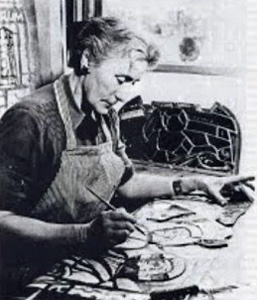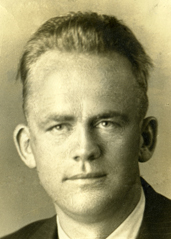
Stained glass is colored glass as a material or works created from it. Although, it is traditionally made in flat panels and used as windows, the creations of modern stained glass artists also include three-dimensional structures and sculpture. Modern vernacular usage has often extended the term "stained glass" to include domestic lead light and objets d'art created from foil glasswork exemplified in the famous lamps of Louis Comfort Tiffany.

Conrad Schmitt Studios is an architectural arts studio located in New Berlin, Wisconsin. It provides ecclesiastical art, stained glass artistry, art glass, decorative painting, mosaics, murals and sculptural arts. The studio specializes in restoration services for buildings of architectural, historical and religious significance. Founded in 1889 by German-American artist Conrad Schmitt, the company is one of the oldest and largest glass studios in the United States.
The firm of James Powell and Sons, also known as Whitefriars Glass, were London-based English glassmakers, leadlighters and stained-glass window manufacturers. As Whitefriars Glass, the company existed from the 18th century, but became well known as a result of the 19th-century Gothic Revival and the demand for stained glass windows.

Clayton and Bell was one of the most prolific and proficient British workshops of stained-glass windows during the latter half of the 19th century and early 20th century. The partners were John Richard Clayton (1827–1913) and Alfred Bell (1832–1895). The company was founded in 1855 and continued until 1993. Their windows are found throughout the United Kingdom, in the United States, Canada, Australia and New Zealand.

Gabriel Loire was a French stained glass artist of the twentieth century whose extensive works, portraying various persons or historical scenes, appear in many venues around the world. He founded the Loire Studio in Chartres, France which continues to produce stained glass windows. Loire was a leader in the modern use of "slab glass", which is much thicker and stronger than the stained glass technique of the Middle Ages. The figures in his windows are mostly Impressionistic in style.
Johannes Stephanus Theron known professionally as Leo Théron was a South African stained-glass window artist who specialises in the dalles de verre technique.

Lawrence Stanley Lee was a British stained glass artist whose work spanned the latter half of the 20th century. He was best known for leading the project to create ten windows for the nave of the new Coventry Cathedral. His other work includes windows at Guildford and Southwark Cathedrals as well as a great number of works elsewhere in the UK, and some in Canada, Australia and New Zealand.

Hugh Arnold was an English stained glass artist. Arnold was educated at the Slade School of Fine Art before attending the London County Council (LCC) Central School of Arts and Crafts where he studied under Christopher Whall from 1989 to 1903. He designed stained glass windows for James Powell & Sons and also did some independent work. While an officer in the Northumberland Fusiliers, Arnold died on active service at Gallipoli in 1915.
Dalle de verre, from French: "glass slab", is a glass art technique that uses pieces of coloured glass set in a matrix of concrete and epoxy resin or other supporting material.

Katharine Lamb Tait was an American stained glass and mosaics designer, painter, muralist, and illustrator. She was the head designer at J&R Lamb Studios for more than four decades, and created notable commissions for the Tuskegee Institute Chapel and for chapels at the United States Marine Corps’ Camp Lejeune, among others.
Jean-Jacques Duval was a French-born American artist who pioneered abstract art and the use of faceted glass in stained glass design in the 1960s. In 2005 he was awarded the Lifetime Achievement Award by the Stained Glass Association of America. Best known for his window designs in Germany, Israel, Japan, the West Indies, and the United States, his paintings and sculptures have also been exhibited throughout North America.
Gerard Thomas Goalen was a British architect who specialised in church architecture and was influenced by continental models and the Liturgical Movement. He was one of the most important architects of the Catholic Modernist movement in the United Kingdom during the 20th century.
Charles Norris OSB (1909–2004) was a Benedictine monk and dalle de verre stained glass artist who created works for Roman Catholic churches in the UK.

Art Nouveau glass is fine glass in the Art Nouveau style. Typically the forms are undulating, sinuous and colorful art, usually inspired by natural forms. Pieces are generally larger than drinking glasses, and decorative rather than practical, other than for use as vases and lighting fittings; there is little tableware. Prominently makers, from the 1890s onwards, are in France René Lalique, Emile Gallé and the Daum brothers, the American Louis Comfort Tiffany, Christopher Dresser in Scotland and England, and Friedrich Zitzman, Karl Koepping and Max Ritter von Spaun in Germany. Art Nouveau glass included decorative objects, vases, lamps, and stained glass windows. It was usually made by hand, and was usually colored with metal oxides while in a molten state in a furnace.

Carl Huneke was a German-American stained glass artist and master craftsman.
Keith New was a stained glass artist and craftsman during his early career and a well-regarded teacher and landscape painter in later life. After studying at the Royal College of Art (RCA) New returned there, heading the RCA Stained Glass Department from 1955-1958. He served as Head of Art & Design at the Central School of Art from 1957-1964. He was Head of Foundation Studies at Kingston School of Art from 1968-1991. In 1965 New became a Brother of the Art Workers Guild.
John 'Jack' Baker (1916-2007) was a British stained-glass artist, teacher, conservator and author.

Stained glass was first imported to Latin America during the 17th-18th century by Portuguese and Spanish settlers. For some countries, however, stained glass was imported much later.










